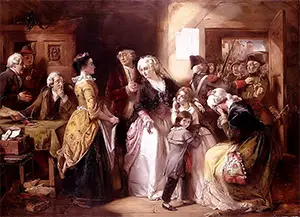The War of the First Coalition
Part 1: Revolution as a Cause for War The War of the First Coalition was a five-year struggle between France and a handful of other European countries during the French Revolution. The onset of the Revolution had resulted in large-scale upheaval across the economic and political spectrums of France. King Louis XVI had summoned the Estates-General, in an attempt to enact new legislation; instead, a significant number of Third Estate deputies effectively revolted and formed the National Assembly, which became the National Constituent Assembly when a number of members of the First Estate and Second Estate joined as well. One of the prime achievements of the National Constituent Assembly was the creation of the Declaration of the Rights of Man and of the Citizen, in August 1789. In the wake of all that politically charged drive toward equality, a large number of nobles, fearing for their livelihoods and their lives, left the country, migrating to neighbors such as Austria and Prussia. Many of these wished to return to their lands, estates, and (in many cases) families, and consulted with foreign powers about ways to do that. 
For some time, many leaders of the Revolution had feared that the king would try to flee the country. He did just that, on the evening of June 20, 1791. He had taken that action as a result of a secret meeting between representatives of Austria, Sardinia, Spain, and Switzerland that had resulted in a pledge of invasion in order to rescue Louis XVI from his subjects. The king refused such assistance but did accept the offer of safety at Montmédy that was extended by General Bouillé. Thus it was that king and family traveled by carriage on the road to Chãlons, toward Montmédy. The Assembly, having discovered the king's absence, announced that it had assumed executive power and encouraged the army to take an oath to defend the Assembly, not the king. Louis, meanwhile, revealed himself to his subjects at Varennes on June 21 and was arrested and returned to Paris. The Assembly finally achieved what it had set out to do at the beginning, creating the Constitution of 1791. The result was that Louis XVI was still the head of the state, but the state had morphed into a representative body, the legislative arm of which could, given enough time, enact legislation even though the king didn't approve. On Aug. 17, 1791, Prussian King Frederick William II issued the Declaration of Pillnitz, which asked other monarchs of Europe to help restore the French king to his absolutist throne. This served to heighten tensions within the French government, which at that time was run by Girondins, a sect of Jacobinism who wanted to maintain the more republican nature of their country and were willing to go to war to protect it. In fact, many people in France wanted to take their republican movement outside French borders. A significant number of people in the Low Countries (what is now Belgium and the Netherlands) appealed to France to help them achieve the same sort of revolution within their borders. If all other European powers did indeed unite against France in battle, then French troops would be severely outnumbered. That sort of alliance was something that French officials worked very hard to avoid. Foreign Minister Charles François Dumouriez narrowed the list of hostiles to two, Austria and Prussia, through a policy of shrewd diplomacy. At the same time, Dumouriez had encouraged a rebellion in the Austrian Netherlands. The plan was for French troops to invade Austria and then join up with rebellious troops in the Low Countries and defeat the Austrian army. Dumouriez's plan called for a French victory in 15 days. Next page > Advances and Setbacks > Page 1, 2, 3, 4 |
|
Social Studies for Kids
copyright 2002–2024
David White




